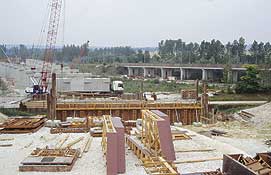Almost every major French civil contractor has a piece of 22 contracts to build the countrys latest high-speed railroad. Even as the railroad owner prepares to award the last civil contract on the $3.9-billion line, it is developing other megaprojects to satisfy French demand for 320-km-per-hour travel on the Train à Grande Vitesse.
 |
| PROGRESS: Contracts to build a $3.9-billion new high-speed Paris-Germany line include a complex connection with existing route. |
About 25% of earthwork on the first 300 km of the Eastern France high-speed line (LGV) heading east from Paris toward Germany has been completed, while nearly 20 bridges are up and an-other 120 in construction. Thanks partly to good weather, progress has the owner, the states Réseau Ferré de France (RFF), generally happy, says project director Patrick Trannoy.
There are several major bridges among the 327 structures along the route from Paris to Buadrecourt, close to Metz. These include a 1.5-km-long viaduct over the Moselle River valley. At the eastern end, the twin steel girders of a 415-m-long, eight-span viaduct are now being pushed into place in a contract that includes a challenging intersection with the existing LGV around Paris.
A consortium of Paris-based Eiffage S.A. subsidiaries last month began launching the 4,000-tonne deck girder in 12.5-m lengths from one abutment. The job should be done by years end, says Daniel Maleron, the joint ventures head of bridges. The viaduct forms part of a $73-million contract, including 3.3 km of line and 11 km of interconnection.
|
Viaduct work has gone smoothly, according to Maleron. But access problems at a major highway elsewhere along the route created a two-month delay, says Jean-Baptiste Ridoret, an engineer with French National Railways (SNCF), the contracts designer/supervisor.
SNCF was once the major owner of French rail, but it now no longer owns the 32,000 km of track and must compete for work on new projects. SNCFs diminished role stems from the RFFs creation six years ago. Its purpose was partly to relieve SNCF of debt exceeding $23 billion, accumulated largely from its TGV development, says Trannoy. RFF initially was required to outsource all infrastructure work to SNCF, but has since increased its own role, doubling staff to about 400. In its roughly $2-billion yearly investment program, "all the big projects [now] are managed by people from RFF," says Trannoy.
Nevertheless, SNCF won half the Eastern LGVs six design/supervise contracts, amounting to some $1.5 billion, with the rest going to design firms. SNCF also retains design responsibility for fixed equipment. With track and electrical items supplied separately, instal-lation contracts are modest. All three electrification jobs have been awarded and RFF expects to let track contracts this September.
The government was unable to finance the entire 406-km route to Strasbourgone of the two seats of the European Parliamentand is focusing on completing the first 300 km by 2007. The state is funding 40% of the cost, with the rest divided between the European Union and 17 local authorities along the route. Even tiny, neighboring Luxembourg is chipping in nearly 4%.
The eastern LGVs missing link to Strasbourg remains in limbo, but RFF has begun design of the roughly 200-km Mulhouse-Dijon section of the planned 425-km Rhine-Rhône LGV, says Trannoy. That project awaits government financial sanction before moving to construction.
The company is developing other routes as well. Among these is the first phase of the planned 300-km-long Tours-Bordeaux route to the Atlantic coast. Preliminary design by consultants is almost done. Another is the roughly 100-km-long LGV between Le Mans and Rennes, in Brittany. Other projects include the Pyrenees tunnel crossing to Spain near Perpignan, which is being rebid after negotiations with a preferred bidder failed. More ambitiously, RFF and its Italian counterpart are planning a $9-billion, 50-km tunneled route through the Alps on the Lyon-Turin line.



Post a comment to this article
Report Abusive Comment